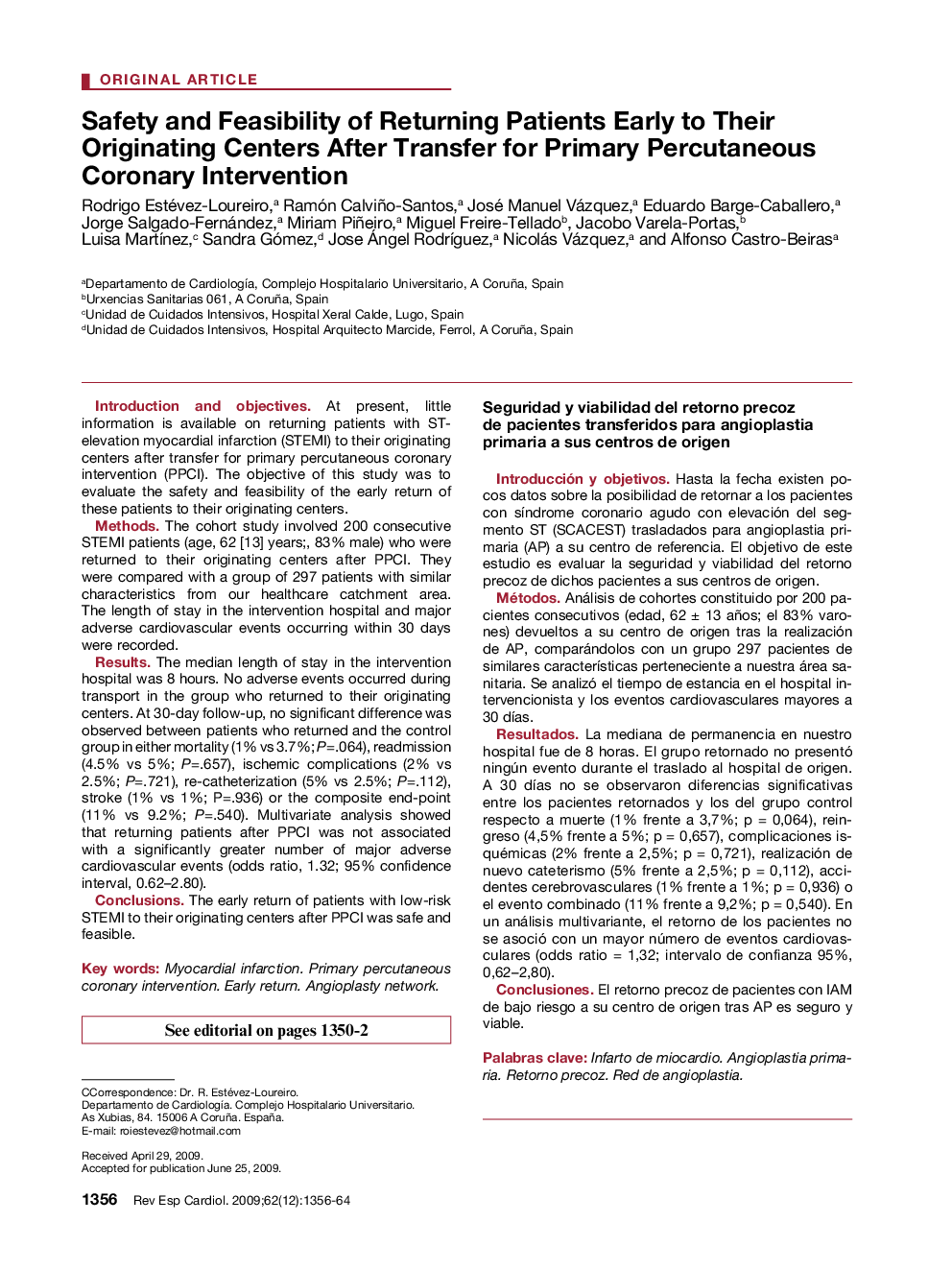| Article ID | Journal | Published Year | Pages | File Type |
|---|---|---|---|---|
| 3018824 | Revista Española de Cardiología (English Edition) | 2009 | 9 Pages |
Introduction and objectivesAt present, little information is available on returning patients with ST-elevation myocardial infarction (STEMI) to their originating centers after transfer for primary percutaneous coronary intervention (PPCI). The objective of this study was to evaluate the safety and feasibility of the early return of these patients to their originating centers.MethodsThe cohort study involved 200 consecutive STEMI patients (age, 62 [13] years;, 83% male) who were returned to their originating centers after PPCI. They were compared with a group of 297 patients with similar characteristics from our healthcare catchment area. The length of stay in the intervention hospital and major adverse cardiovascular events occurring within 30 days were recorded.ResultsThe median length of stay in the intervention hospital was 8 hours. No adverse events occurred during transport in the group who returned to their originating centers. At 30-day follow-up, no significant difference was observed between patients who returned and the control group in either mortality (1% vs 3.7%; P=.064), readmission (4.5% vs 5%; P=.657), ischemic complications (2% vs 2.5%; P=.721), re-catheterization (5% vs 2.5%; P=.112), stroke (1% vs 1%; P=.936) or the composite end-point (11% vs 9.2%; P=.540). Multivariate analysis showed that returning patients after PPCI was not associated with a significantly greater number of major adverse cardiovascular events (odds ratio, 1.32; 95% confidence interval, 0.62-2.80).ConclusionsThe early return of patients with low-risk STEMI to their originating centers after PPCI was safe and feasible.
Introducción y objetivosHasta la fecha existen pocos datos sobre la posibilidad de retornar a los pacientes con síndrome coronario agudo con elevación del segmento ST (SCACEST) trasladados para angioplastia primaria (AP) a su centro de referencia. El objetivo de este estudio es evaluar la seguridad y viabilidad del retorno precoz de dichos pacientes a sus centros de origen.MétodosAnálisis de cohortes constituido por 200 pacientes consecutivos (edad, 62 ± 13 años; el 83% varones) devueltos a su centro de origen tras la realización de AP, comparándolos con un grupo 297 pacientes de similares características perteneciente a nuestra área sanitaria. Se analizó el tiempo de estancia en el hospital intervencionista y los eventos cardiovasculares mayores a 30 días.ResultadosLa mediana de permanencia en nuestro hospital fue de 8 horas. El grupo retornado no presentó ningún evento durante el traslado al hospital de origen. A 30 días no se observaron diferencias significativas entre los pacientes retornados y los del grupo control respecto a muerte (1% frente a 3,7%; p = 0,064), reingreso (4,5% frente a 5%; p = 0,657), complicaciones isquémicas (2% frente a 2,5%; p = 0,721), realización de nuevo cateterismo (5% frente a 2,5%; p = 0,112), accidentes cerebrovasculares (1% frente a 1%; p = 0,936) o el evento combinado (11% frente a 9,2%; p = 0,540). En un análisis multivariante, el retorno de los pacientes no se asoció con un mayor número de eventos cardiovasculares (odds ratio = 1,32; intervalo de confianza 95%, 0,62-2,80).ConclusionesEl retorno precoz de pacientes con IAM de bajo riesgo a su centro de origen tras AP es seguro y viable.
